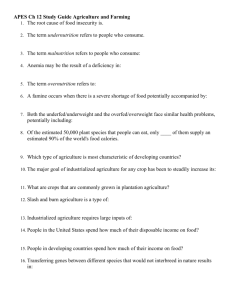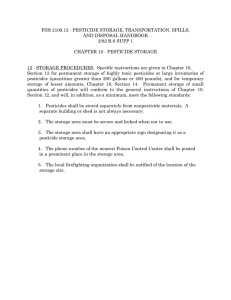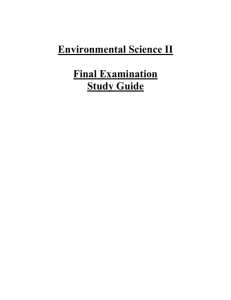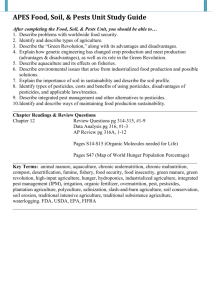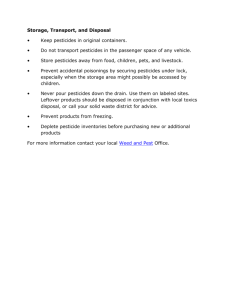Land and Water Use Practice Test
advertisement
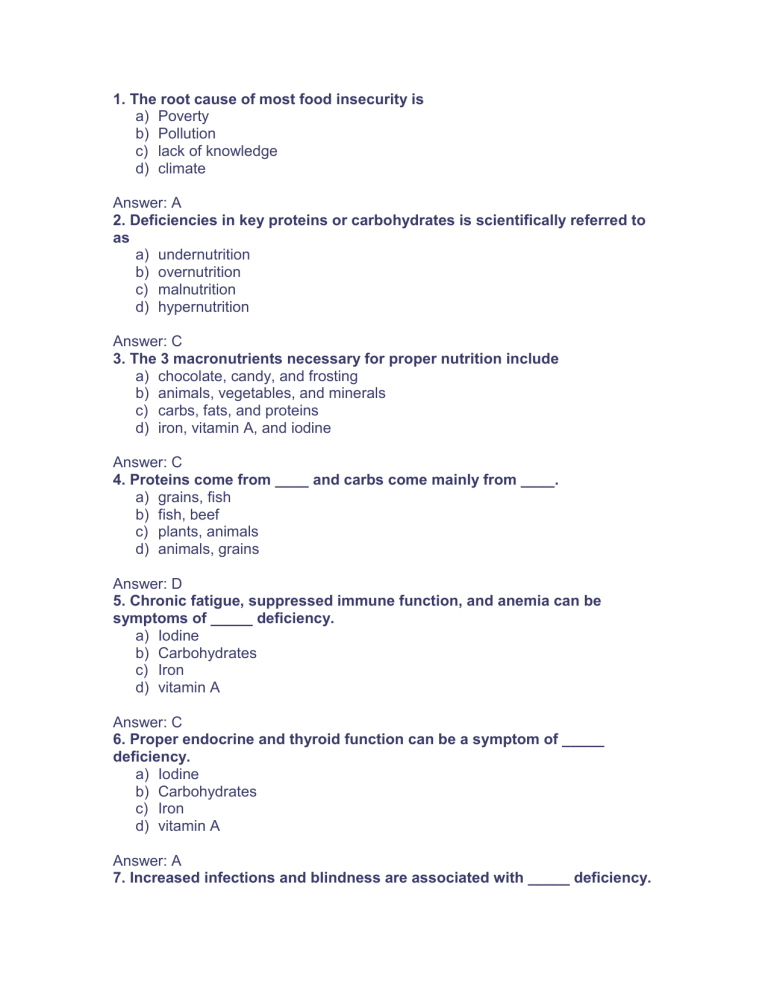
1. The root cause of most food insecurity is a) Poverty b) Pollution c) lack of knowledge d) climate Answer: A 2. Deficiencies in key proteins or carbohydrates is scientifically referred to as a) undernutrition b) overnutrition c) malnutrition d) hypernutrition Answer: C 3. The 3 macronutrients necessary for proper nutrition include a) chocolate, candy, and frosting b) animals, vegetables, and minerals c) carbs, fats, and proteins d) iron, vitamin A, and iodine Answer: C 4. Proteins come from ____ and carbs come mainly from ____. a) grains, fish b) fish, beef c) plants, animals d) animals, grains Answer: D 5. Chronic fatigue, suppressed immune function, and anemia can be symptoms of _____ deficiency. a) Iodine b) Carbohydrates c) Iron d) vitamin A Answer: C 6. Proper endocrine and thyroid function can be a symptom of _____ deficiency. a) Iodine b) Carbohydrates c) Iron d) vitamin A Answer: A 7. Increased infections and blindness are associated with _____ deficiency. a) b) c) d) iodine carbohydrates iron vitamin A Answer: D 8. Our 3 main food systems are (by ranking) a) croplands, feedlots, fisheries b) free range farms, small fisheries, plantations c) feedlots, fisheries, small farms d) aquaculture, rangelands, farmland Answer: A 9. The 3 main grain crops (in any order) grown in the US are: a) rice, kale, and corn b) wheat, barley, and hops c) corn, wheat, and rice d) hemp, corn, and rice Answer: C 10. Industrialized agriculture is associated with all of these, except: a) plantations b) polycultures c) maximizing crop yield d) greenhouses Answer: B 11. All of these are typical cash crops grown in plantation agriculture, except: a) bananas b) corn c) coffee d) sugarcane Answer: B 12. Slash-and-burn is associated with a) traditional agriculture b) plantations c) high-input of resources d) industrialized countries Answer: A 13. The first green revolution included all of these practices, except: a) maximizing crop yield b) using large amounts of fertilizers c) multi-cropping d) organic farming techniques Answer: D 14. The second green revolution focused on all of these, except: a) increasing world grain production b) fast-growing rice and wheat c) growing more food on less land d) organic farming techniques Answer: D 15. Under the agribusiness model, all of these have occurred in the US, except: a) the number of giant companies has decreased b) agriculture is bigger than most other industries combined c) food production has become more efficient d) consumer now spend more $ than before on food Answer: D 16. Cross-breeding is a a) relatively old method of artificial selection b) new modern technique to blend multiple plants c) technique that takes decades to occur d) process that has produced limited benefits Answer: A 17. The most fertile soils take ___years to develop ___cm. a) 10; 10 b) 100 ; 10 c) 1000 ; 1 d) 100,000 ; 0.1 Answer: C 18. The order of soil horizons from top to bottom is a) O, E, C, B, A b) O, C, A, B, E c) O, A, E, B, C d) A, B, C, E, O Answer: C 19. The leaf litter that will enrich the topsoil beneath it makes up the ___horizon. a) b) c) d) O A E B Answer: A 20. Broken down bedrock (the foundation of good soil) is found in the ___ horizon. a) O b) B c) E d) C Answer: D 21. Dirt differs from soil because it lacks a) Water b) Air c) Humus d) Carbon Answer: C 22. All soil profiles begin as a) weathered bedrock b) thick humus c) unweathered bedrock d) sand, silt, and clay Answer: C 23. The largest cause of soil erosion and removal of topsoil is/are a) flowing water b) strong wind c) industrial monoculture d) clear-cutting forests Answer: A 24. Two major effects of soil erosion are a) water pollution and soil infertility b) desertification and salinization c) salinization and water pollution d) soil infertility and desertification Answer: A 25. Desertification usually occurs when a) humans leave an area alone to undergo secondary succession b) soil productivity decreases due to drought and poor farming practices c) winds carry large amounts of sand from nearby deserts d) irrigation water is continually used in arid regions of the country Answer: B 26. excessive irrigation in drier climates leads to a) local and regional flash flooding b) increased water tables c) increased soil salinization d) increased crop yields Answer: C 27. The industrialized agriculture system shuts down without what key ingredient? a) cheap fossil fuel energy b) genetically modified organisms c) efficient food processing plants d) The Food Quality Protection Act Answer: A 28. The Food Quality Protection Act a) bans the use of DDT, dioxin, PCBs, and pesticides on all US produced food b) requires the EPA to reduce pesticide use when the effects on children is unknown c) regulates the use of genetically modified organisms inn food produced within the US d) encourages fast-food chains to report the ingredients on all food items they sell Answer: B 29. Under FIFRA... a) the EPA assesses health risks of active ingredients in pesticides b) all pesticides are registered with the FDA, EPA, and USDA c) the US may not use any pesticides that it produces by itself d) all food imported must pass strict guidelines for pesticides present Answer: A 30. Nicotine sulfate is an example of a a) first generation pesticide b) pesticide developed synthetically c) second generation pesticide d) teratogen Answer: A 31. Modern (2nd gen) pesticides have many advantages...NOT including a) saving human lives through their use b) eliminating genetic resistance c) increasing agricultural yields d) fast-acting results Answer: B 32. Which of these is FALSE about modern (2nd gen) pesticides? a) b) c) d) They often kill natural predators They may runoff into nearby aquatic systems They become more effective over time. They promote genetic resistance. Answer: C 33. Top-level predators often eat indirectly absorb toxins as a result of a) bioaccumulation b) persistence c) overnutrition d) biomagnification Answer: D 34. Alternatives to using pesticides include (all of these except) a) using monocultures to single out pests b) using genetic engineering within plants c) using pheromones to lure pests d) using hot water to scald the pests Answer: A 35. Under the integrated pest management system, the first line of defense during an infestation is to use a) biologic methods b) DDT c) genetic engineering d) broad range pesticides Answer: A
